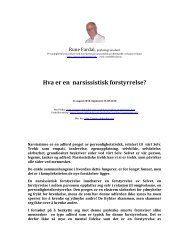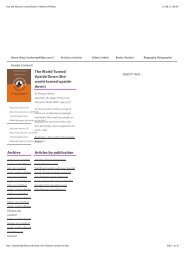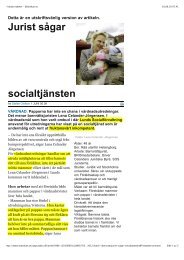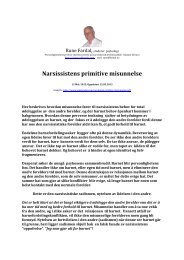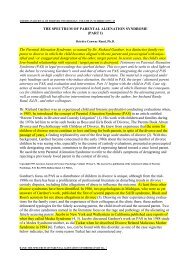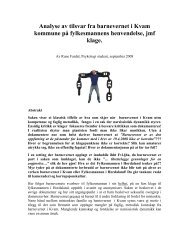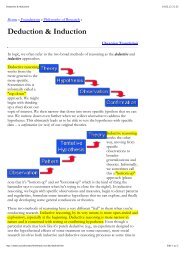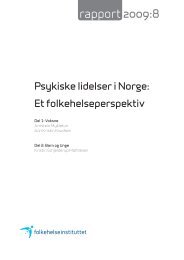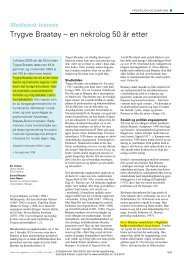The origins of narcissism and narcissistic personality disorder a
The origins of narcissism and narcissistic personality disorder a
The origins of narcissism and narcissistic personality disorder a
Create successful ePaper yourself
Turn your PDF publications into a flip-book with our unique Google optimized e-Paper software.
60 JOHN S. AUERBACH<br />
bolic thinking (Kagan, 1981; Piaget, 1945/1962; Stern, 1985) is the<br />
consolidation <strong>of</strong> children’s ability to recognize themselves in the mirror<br />
(Amsterdam & Levitt, 1980; M. Lewis & Brooks-Gunn, 1979). It is this<br />
ability to construct an image <strong>of</strong> one’s body, per Freud’s (1914/1957)<br />
early theory, that brings about <strong>narcissism</strong>. Thus, to cite the ideas <strong>of</strong><br />
but a few <strong>of</strong> the theorists just discussed, Mahler et al.’s (1975) rapprochement<br />
stage, Winnicott’s (1953, 1971/1982) transitional object<br />
stage, Grunberger’s (1971/1979; cf. Freud, 1917/1955) emphasis on<br />
the anal stage as the period in which <strong>narcissistic</strong> <strong>and</strong> object-related<br />
wishes first come into conflict, <strong>and</strong> Kernberg’s (1975, 1976) reformulation<br />
<strong>of</strong> Melanie Klein’s (1935) depressive position as emerging in the<br />
second year <strong>of</strong> life constitute alternative perspectives for delineating<br />
the momentous, potentially traumatic consequences <strong>of</strong> the infant’s discovery<br />
<strong>of</strong> the self. <strong>The</strong> transitional object, ins<strong>of</strong>ar as it is an illusion<br />
that helps a toddler cope with separation from mother in particular<br />
<strong>and</strong> with the discovery <strong>of</strong> separateness in general, is perhaps the most<br />
evocative example <strong>of</strong> the origin <strong>of</strong> <strong>narcissistic</strong> fantasy. To these various<br />
conceptualizations, one can add Lacan’s (1948/1977,1949/1977,1953)<br />
mirror stage, to be reviewed briefly before this discussion moves on<br />
to consider the infant as seen through the eyes <strong>of</strong> empirical research.<br />
Because Lacan’s (1948/1977, 1949/1977, 1953) views <strong>of</strong> <strong>narcissism</strong><br />
<strong>and</strong> early development derive chiefly from Freud’s (1905/1953, 19141<br />
195 7) earlier, empirically sounder writings on these topics (Laplanche,<br />
19701 1976) <strong>and</strong> involve, perhaps uniquely among major psychoanalytic<br />
theoreticians, a rejection <strong>of</strong> the notion <strong>of</strong> a monadic infant undifferentiated<br />
from <strong>and</strong> unaware <strong>of</strong> its surroundings (Laplanche & Pontalis,<br />
1967/1973; Ragl<strong>and</strong>-Sullivan, 1986), they can be squared, most<br />
surprisingly, with the findings <strong>of</strong> current infancy research much more<br />
readily than can the ideas <strong>of</strong> thinkers who hold that <strong>narcissism</strong> involves<br />
an inability to differentiate between self <strong>and</strong> other (Muller, 1982). Lacan<br />
(1949/1977, 1953), following Freud (1914/1957), argues that <strong>narcissism</strong><br />
involves the emergence <strong>of</strong> the ego as a self-representation-that<br />
is, as a unified self-image that is constituted through self-inflation. <strong>The</strong><br />
mirror stage, a developmental phase occurring between ages 8 <strong>and</strong> 18<br />
months <strong>and</strong> during which infants first come to recognize themselves<br />
in the mirror, is clearly an elaboration <strong>of</strong> Freud’s first theory <strong>of</strong> <strong>narcissism</strong>.




